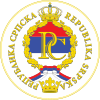 |
|---|
A referendum on remaining in Yugoslavia was held in the parts of Bosnia and Herzegovina with a significant Serb population on 10 November 1991.[1] The referendum was organised by the Bosnian Serb Assembly and asked two questions; to Serbs it asked:
Do you agree with the decision of Assembly of the Serbian people in Bosnia and Herzegovina of October 24, 1991, that the Serbian people should remain in a common Yugoslav state with Serbia, Montenegro, the SAO Krajina, SAO Slavonija, Baranja and Western Srem, and with others who have come out for remaining?[2]
Non-Serbs were asked:
Are you agreed that Bosnia and Herzegovina, as an equal republic, should remain in a common state of Yugoslavia with all others who take this position?[2]
It was approved by 98% of voters, and Republika Srpska was subsequently established on 9 January 1992.[1]
Results
| Question | For | Against | Invalid/ blank |
Total votes |
Registered voters |
Turnout | Result | ||
|---|---|---|---|---|---|---|---|---|---|
| Votes | % | Votes | % | ||||||
| Remaining of all Serbs in Yugoslavia | 1,161,146 | 98.00 | 2.00 | 1,550,000 | 85.00 | Approved | |||
| Bosnia-Herzegovina to remain in Yugoslavia | 48,845 | Approved | |||||||
| Source: Direct Democracy | |||||||||
Aftermath
The Bosnian government declared the referendum unconstitutional.[3] It later held a nationwide independence referendum between 29 February and 1 March 1992, which was in turn boycotted by most of the Serbs.[4] Steven L. Burg and Paul S. Shoup interpreted the question in the plebiscite, which asked voters to stay in a "common state with Serbia, Montenegro, the SAO Krajina, SAO Slavonija, Baranja and Western Srem, and Serb Autonomous Regions" as promoting, in effect, a Greater Serbia.[5]
References
- ^ a b Bosnien-Herzegowina, serbischer Teil, 10. November 1991 : Unabhängige Serbische Republik in Bosnien-Herzegowina Direct Democracy
- ^ a b Steven L Burg & Paul S Shoup (2000) The War in Bosnia-Herzegovina: Ethnic Conflict and International Intervention M.E. Sharpe, p74
- ^ Nettelfield 2010, p. 67.
- ^ Prosecutor v. Karadžić – Judgement, 24 March 2016, p. 20.
- ^ Burg & Shoup 2015, p. 107.
Books
- Burg, Steven L.; Shoup, Paul S. (2015). Ethnic Conflict and International Intervention: Crisis in Bosnia-Herzegovina, 1990-93: Crisis in Bosnia-Herzegovina. Routledge. ISBN 9781317471011.
- Nettelfield, Lara J. (2010). Courting Democracy in Bosnia and Herzegovina. Cambridge, England: Cambridge University Press. ISBN 978-0-521-76380-6. LCCN 2010002815.
Other
- "Prosecutor vs. Radovan Karadžić – Judgement" (PDF). International Criminal Tribunal for the Former Yugoslavia. 26 March 2016.
